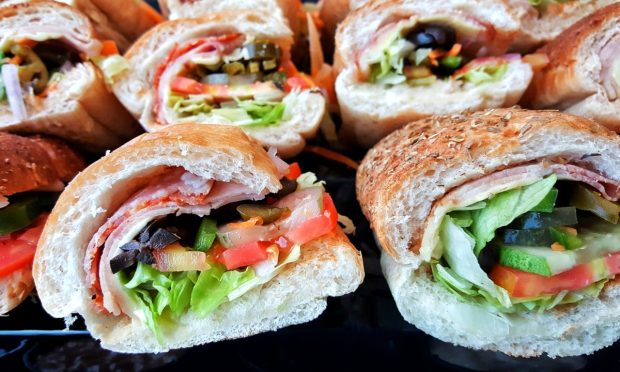Subway: Convenience Takes Priority Over Customization for Catering Customers

As restaurants seek to meet consumers’ increasing expectations of omnichannel convenience, those that can bring additional dining occasions into the digital space have the opportunity to embed their offerings in more parts of consumers’ daily routines.
Quick-service restaurant (QSR) sandwich chain Subway, for one, which has nearly 40,000 restaurants worldwide, announced last month that it has redesigned its catering program with easy digital ordering options and that it has launched its offerings on corporate food solutions provider ezCater’s marketplace.
Read more: Subway Woos Corporate Crowd With Catering Relaunch
Subway Director of Catering Jenn Saunders-Haynes explained in an interview with PYMNTS how consumers’ catering needs are similar to and different from their expectations from other digital ordering categories.
“Before redesigning our catering program, we invested in extensive research to understand what guests really want from catering in today’s environment,” Saunders-Haynes said. “We … identified some key trends in catering that have helped guide our program. First, our guests are looking for simple and convenient options to make decision-making easy, which is why we’re leaning into easy order and preselected catering options. And health and safety also continue to be top of mind, so we’ve shifted to individually wrapped sandwiches and single-serve condiments.”
Customization Versus Convenience
One of the main ways that the catering customer is different from the single-serve customer is that, in contrast to the trend toward customization and flexibility in individual ordering, consumers expect pre-selected options for group orders, opting for convenience instead of choice.
“As part of our research, we learned about the key differences between our in-restaurant and catering guests,” said Saunders-Haynes. “The Subway model has been built on the desire for customization, but we’re seeing that shift, especially when it comes to catering … [to] prioritizing simplicity and turnkey solutions.”
The updated catering program features preselected platters and lunch boxes, and Saunders-Haynes noted that the “easy-order lunch boxes” are among the “most popular items” available for catering orders.
This difference between individual ordering customers’ expectations of customization opportunities and catering customers’ demand for speed and convenience makes sense, given that the amount of time and communication it would take to tailor every serving to the exact needs of every member of a large group could be prohibitive, while people have no difficulty selecting for their individual preferences when they are the ones placing the order.
Saunders-Haynes explained that the popularity of options to enable customers to choose from “fully-built meal options without having to select every sandwich variety or topping themselves” has exceeded expectations.
Bring It on Home
When it comes to individual orders, meanwhile, digital ordering remains elevated even now that safety concerns have largely faded to the background for many consumers.
“We’ve continued to see an increased demand for pickup and delivery orders since guests are prioritizing convenience,” said Saunders-Haynes. “Our pickup and Subway Delivery programs, which launched last year, have led to a significant boost in sales.”
Indeed, consumers have increased their delivery and pickup ordering. Findings from PYMNTS’ 2021 How We Eat Playbook, created in collaboration with Carat from Fiserv, revealed that consumers now are 31% more likely to buy meals for delivery or pickup than they are to dine on-site. Moreover, 43% of all consumers reported that they are ordering home delivery for their restaurant meals or groceries more often now than they did before March 2020, and 48% said the same of pickup.
See more: Restaurants and Grocers See Path to Picking up 200M New Customers
This shift also affects group ordering catering businesses, with the return to in-person events creating occasions for such purchases.
“Catering has mirrored this trend as in-person gatherings are on the rise,” Saunders-Haynes said.
Back to Work
Part of the goal of this catering business is to capture the demand from employers for attractive incentives to bring consumers back into the office (or to soften the blow if returning is mandatory) at a time when hybrid or fully remote work has become the norm for many. Saunders-Haynes noted that offering complimentary food is “one of the biggest draws to ease the transition.”
These perks can be especially effective at a time when restaurant inflation has many office workers shocked by the price increases of their pre-pandemic workday lunch favorites. For instance, data from Square released in March revealed that the cost of wraps was up 18% year over year, and sandwiches increased 14%. In contrast, restaurant meal prices overall were up 6.9% in March, according to data released in April from the Bureau of Labor Statistics (BLS) Consumer Price Index for all Urban Consumers (CPI-U).
Read more: Workers Facing ‘Lunchflation’ as They Return to Their Offices
“We … recognize that the rise in hybrid and remote working will continue to be an important consideration for us and the industry as a whole,” said Saunders-Haynes. “As we continue to evaluate our program, we have a dedicated team to keep a finger on the pulse of the current environment to guide how we adapt and enhance our program to meet and exceed our guests’ expectations.”
